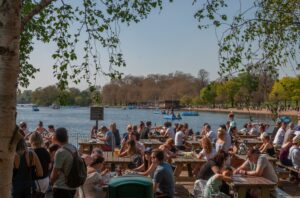English and Welsh green spaces worth £25.6bn per year
Councils warned about short-sighted parkland budget cuts as report shows huge ‘welfare value’ added by nature.
Green spaces in England and Wales are worth £25.6bn each year, according to research funded by the Department for Environment, Food, and Rural Affairs.
The government department has created an outdoor recreation valuation tool, Orval, which assesses the value provided by every park, woodland, riverside walk, country path, and beach in the two nations. The tool also helps identify which residents enjoy the benefits of nature most, and when they use the areas.
As a result of this work, the top 10 most valuable recreation sites have also been ranked, all of which are found in urban areas, with London’s Hyde Park listed at number one, followed by Sutton Park, Birmingham, Blaise Castle estate in Bristol, Hampstead Heath, London, and Windsor Great Park, Windsor. Natural spaces in Liverpool, Southampton and Cardiff also appeared in the list.
In terms of demographics, the Orval analysis found that white people are 1.8 times more likely to use recreation sites compared to a Black person, while the richest socio-economic groups were 1.6 times more likely to make the most of spaces compared to those at the bottom of the income spectrum.
‘The great contribution of this study is that it puts a figure to the value of our green spaces: £25.6bn a year,’ said Brett Day, professor of environmental economics at the University of Exeter, one of the research authors. ‘The size of that benefit stands in stark contrast to the deep cuts in green space budgets across UK councils, cuts that threaten to condemn our green spaces to neglect and disrepair.
‘The Orval tool makes explicit the very real, but all-too-often-ignored, losses that people endure as a consequence,’ he continued. ‘Recreational access is not the same for all people, not just because of where they live but because of things like access to a car. Orval can show decision-makers how to locate new facilities in a way that will provide the most benefit to more disadvantaged groups and give them better access to the environment.’
Image credit: Neil de Souza







 Network
Network
